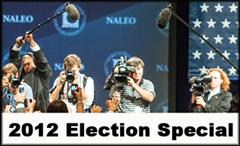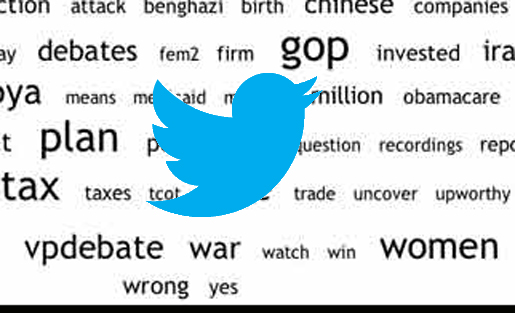Political magazines have found a new way to be opinion leaders during this election — in just 140 characters. Twitter is helping them publicize their print and online content and offer real-time interpretation and analysis. Reaching audiences well beyond their print readership, these magazines’ tweets may be affecting conversations about the election in intriguing ways.

Since October 1, I’ve been collecting tweets related to 17 well-known U.S. political magazines for a new research project. The project will examine how these magazines are using Twitter during the last phase of the 2012 election. I’m curious about how social media are offering new opportunities for mobilizing magazine audiences. The 17 magazines combined have a Twitter audience of almost 700,000 followers, with the potential for reaching many more people.
I’ve already collected more than 216,000 tweets that were either sent by these magazines’ primary Twitter accounts or that mentioned their account names in a conversation or retweet.
This archive will grow much larger during the last days of the campaign, and a detailed analysis with conclusive findings will take time. But with the help of some of the automated features of the archiving service I’m using, I can share a very preliminary sneak peek at some of the trends in the archive.
Mother Jones, The Nation and Upworthy
Among the magazines, Mother Jones is clearly the most visible, followed by The Nation, Newsmax and Weekly Standard, as shown in the word cloud below. The more partisan magazines seem to get the most notoriety on Twitter. As for Mother Jones, one possible reason for its dominance might also be the high frequency of the terms “47” and “video” — no doubt in connection to the Mitt Romney “47 percent” video that Mother Jones broke on its website. That video gained the magazine an incredible amount of attention on Twitter and elsewhere.

An unusual term in the cloud is “stopandfrisk,” which appeared in about 2,400 of the tweets. This one relates to The Nation’s release of an exclusive video that shows an aggressive and possibly discriminatory NYPD stop-and-frisk of a 16-year-old Harlem student.
Viral content specialist Upworthy picked up The Nation’s coverage and spread it rapidly. About 1,800 of the “stopandfrisk” tweets look like they are Upworthy tweets or retweets. Unfortunately for The Nation, these all send readers to the Upworthy site, not to The Nation’s own site — though The Nation’s Twitter username is mentioned in the original tweet, and The Nation is credited on the Upworthy site.
Aside from the candidates, a couple of people show up in this cloud. One is @NicholsUprising — John Nichols, who writes for The Nation and has more than 12,000 followers of his own. The other is Ed Schultz, who appears in the word cloud as both @WeGotEd and @edshow, and whose hashtag #edshow also adds to his prominence in this archive. Nichols often appears on Schultz’s radio and TV programs, and many tweets mention both jointly. Nichols’ individual status and media appearances also support The Nation’s own popularity on Twitter.
Among the many issue-related words in this cloud — women, Iran, policy — there are just two words that suggest evaluations of issues or people, and they’re both negative: don’t (missing its apostrophe) and wrong. I wonder if political magazines are driving Twitter discussion primarily through negative framing of issues and candidates. Maybe people are more likely to click negatively phrased tweets that resonate with their existing political opinions, but does that negativity alter those readers’ interpretation of the magazine content they get when they click through?
The possibility of this negative framing also brings up the usual questions about the media’s role in increasing cynicism among voters, and about the difficulty of getting people to engage opposing perspectives in their social media use.
Finding the Issues
When I eliminate all of the obvious election-related terms from the word cloud and also take out those mentioned above, the cloud demonstrates the wide variety of issues discussed in this election, and reveals some connections that magazines have made to events of the moment.

The debates were major topics of discussion for these political magazines on Twitter. About 3,800 of these tweets included the hashtag #debates, though these weren’t necessarily live tweets of the debates as they happened. Using hashtags — including #p2, #fem2 and #tcot — helps the magazines become visible across all the conversations using those hashtags. It’s a great way for the magazines to gain visibility among people who don’t yet follow the magazines’ Twitter accounts but are interested in similar issues.
Conversative-driven issues such as “Benghazi,” “GOP,” “Obamacare,” “tax” and “war” are prominent in this focused word cloud, and both “debates” and “vpdebate” score high because of how many millions live-tweeted the debates.
Women’s issues also show up here, in “birth” and “control,” “abortions” and, of course, “women.” Some of the “women” tweets include — for better or worse — mentions of binders. But a quick skim of all these tweets shows a variety of concerns about women’s issues, from multiple perspectives.
This word cloud also includes “yes” — a positive word. Could it be an antidote to all the negativity in “wrong” and “don’t?” Again, I’ll have to take a closer look at how exactly the magazines are constructing the questions they’re answering with “yes” for their readers. Political magazines could be guiding readers to particular evaluations of political issues and candidates through tweeted rhetorical questions and partisan answers. That thought leadership is a long-established role for these magazines, of course, but we don’t yet know how this role will work in the social media realm.
I know I’m just scraping the surface in this initial glance at the still-incomplete data. I’d welcome your feedback on what you think political magazines have done well, or not, during this election, and what else I should look for when I start digging into this archive.
Note: The magazines included in this study are: The American Conservative, American Prospect, The American Spectator, Dissent, Human Events, In These Times, Monthly Review, Mother Jones, The Nation, National Interest, National Review, New Internationalist, The New Republic, Newsmax, The Progressive, Reason, and Weekly Standard.
Susan Currie Sivek, Ph.D., is an assistant professor in the Department of Mass Communication at Linfield College. Her research focuses on magazines and media communities. She also blogs at sivekmedia.com, and is the magazine correspondent for MediaShift.

